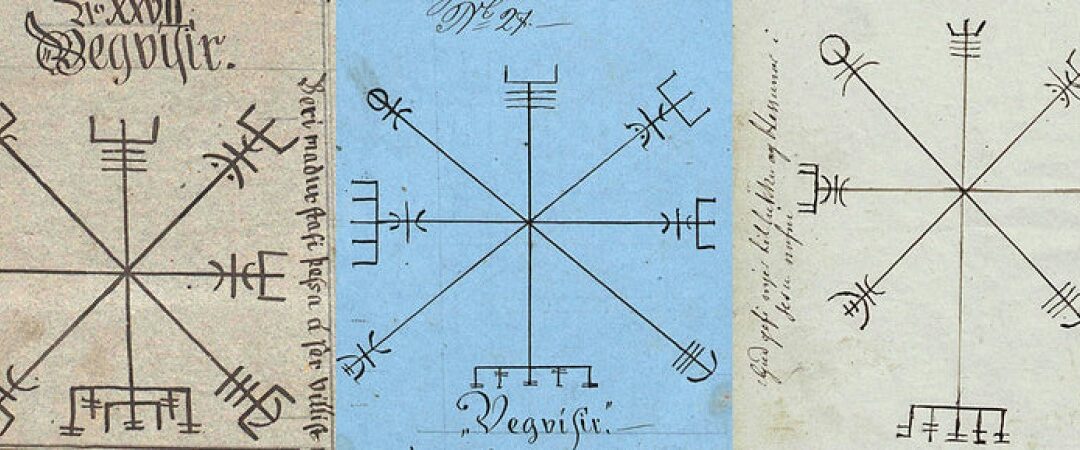The Runic Compass, Vegvisir
The vegvisir is a symbol dating back to medieval Icelandic magical staves, designed to be worn as an amulet or spell cast by the user. It is believed to be a protective symbol that helps guide people through storms, fog, and difficult terrain. As such, it is seen as a charm of protection, providing guidance and helping the wearer reach their intended destination safely, no matter the conditions. Interestingly enough, vegvisir translates literally from Icelandic to English as “sign post” or “wayfinder”. This fitting description seems to confirm its original purpose, for vegvisirs are said to work similarly to a magnetic compass; giving guidance in times of need and confusion.
What does the word Vegvisir Mean?
The word Vegvisir comes from two Icelandic words, Vegur, meaning destination, way, or road, and Visir, meaning path, guide or viewer, hence, Vegvisir can be literally translated as “wayfinder” or “signpost” in Icelandic.
Where did the Vegvisir Come From?
The vegvisir is a traditional Icelandic stave charm, which has become one of the most popular symbols in modern Viking culture. Its specific origins are not known, with no examples in Viking age archaeology, the earliest images of the vegvisir come from three 1800’s manuscripts describing nordic symbols and magick. It’s possible that the scholars who gathered these manuscripts made up the vegvisir, or that it is a merging of older symbols such as the aegishjalmur with Christian symbols such as the crucifix or the north star.
Historic Records of the Vegvisir
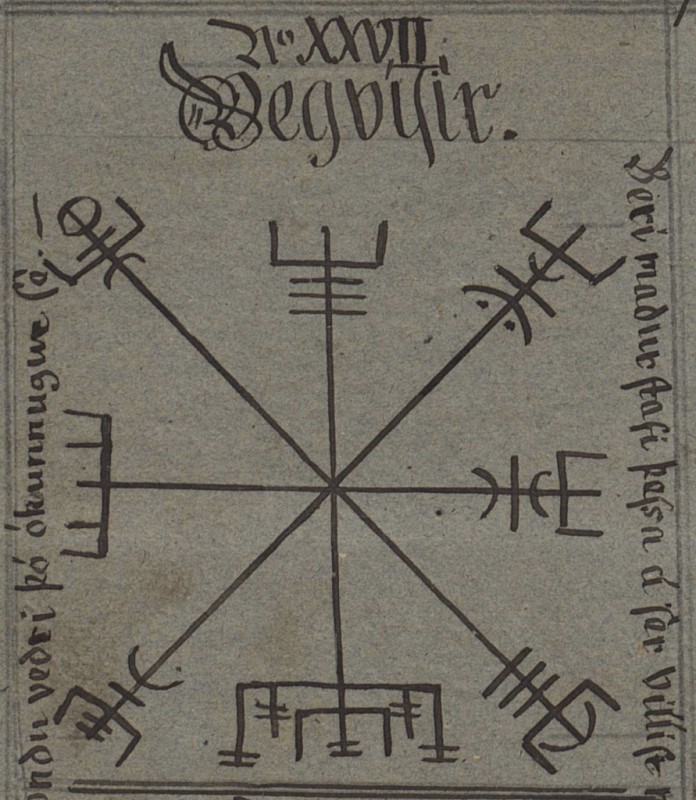
Huld Manuscript by Geir Vigfusson (1860)
The Huld Manuscript is a significant document of Iceland’s pre-Christian period that has remained a fascinating source of intrigue and debate since its discovery more than a century ago. The 20 page vellum manuscript was discovered in 1884 by Icelandic scholar, Jón Árnason, containing an abundance of sketches and mysterious Middle Age runes. Some theorize that the vegvisir symbol which appears in the center spread of the manuscript is an ancient form of Viking compass or guide believed to bring fortune and protection on those who bear it. Although many still question its magical properties, it continues to have deep roots in Icelandic culture to this day.
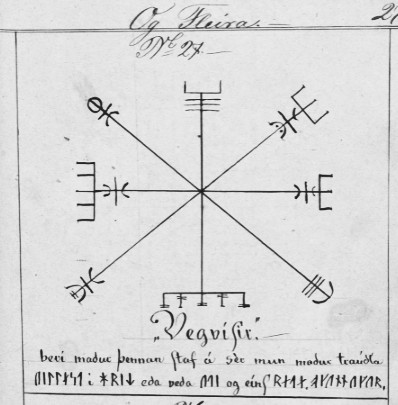
Olgeir Manuscript by Olgeir Geirsson (1868)
Olgeir Geirsson was a manuscript wright in the 19th century Iceland who produced a vegvisir, one of the earliest known magical artifacts. The vegvisir is described as being a compass-like object crafted onto vellum parchment that would help safely guide wayward travelers no matter where they roamed or which direction they traveled. This vegvisir is still widely talked about today, for even those unfamiliar with the arcane arts can see the possibility of such an artifact keeping someone from going astray. Though the vegvisir has been lost to history, many people still remember Olgeir’s work and are inspired by it.
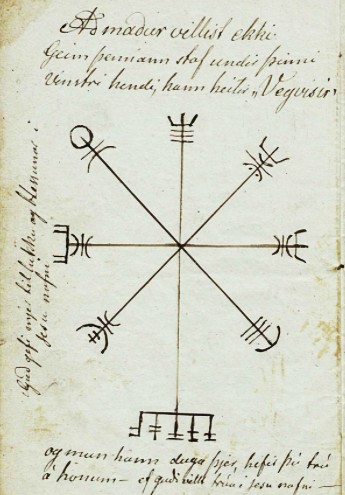
Galdrakver (Spell Book) by Unknown Author (18XX)
The exact age and author of the third recorded Vegvisir is unknown, though believed to be younger than the previous examples, and from a manuscript that was compiled geographically near to Olgeir’s manuscript. Vegvisir, often referred to as the Icelandic magical stave, is a powerful symbol. It is believed to be a protective sign that can help those who use it travel safely and protect them from harm. Vegvisir is represented with eight Viking rune staves radiating outward from a symbolic center. The vegvisir can offer spiritual guidance and protection while on any journey or while facing physical or spiritual challenges. To this day, vegvisir remains an important symbol of protection for many Icelanders.
Modern Revival
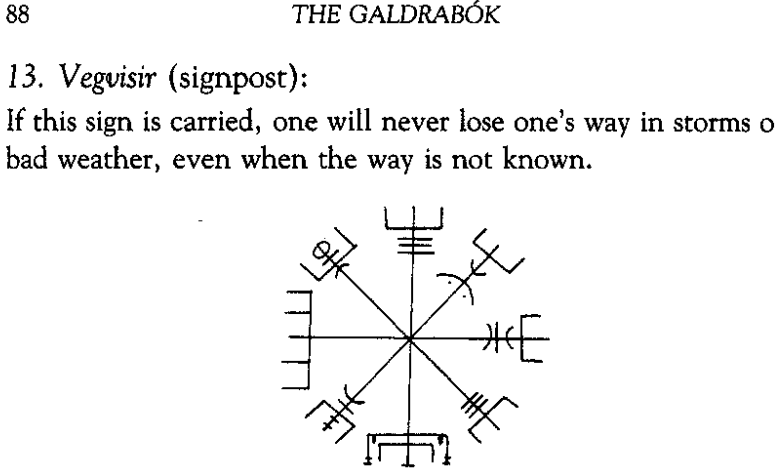
Stephen E. Flowers “The Galdrabok: An Icelandic Grimoire” (1989)
Texan occultist, historian and author Stephen E. Flowers published his translations of a collection of “Galdabrok” (magic books), complete with an image and translation of the passage concerning the Vegvisir in the Huld Manuscript. The translated passage reads: “If this sign is carried, one will never lose one’s way in storms or bad weather, even when the way is not known.” The time this was published, coinciding with the rise of Asatru and other neo pagan movements, and the wide availability of Stephen’s works in libraries and universities likely contributed to the adoption of the Vegvisir as a viking symbol.
Bjork’s Vegvisir Tattoo
Though Bjork Gudmundsdottir first got her large Vegvisir tattoo in 1984, pre-dating Stephen Flowers work, it became internationally recognised in the aftermath of her breakout solo album “Debut” in 1993. Bjork later explained her tattoo and its origin in a 1995 interview with The Rolling Stone. This has inspired countless Bjork fans to emulate the design over the years, and explains its specific popularity as a tattoo design.
Usage of the Vegvisir
Vegvisir Tattoos
Vegvisir tattoos are swiftly becoming a popular choice among body art lovers. Originating in Icelandic folklore, vegvisir translates to ‘wayfinder’ and is intended to be used as a symbol of guidance when lost on long voyages. Many now see vegvisir as an embodiment of strength and direction, with designs often featuring a vegvisir surrounded by protective runes. With the classic style making it versatile for everyone’s individual taste, vegvisir tattoos carry a profound meaning behind their symbolism, so make sure you pick the right design if you decide to get one!
Vegvisir Staves
The vegvisir, which translates to “signpost” in Icelandic, is an ancient symbol that is believed to provide guidance and protection for its bearer. The vegvisir was believed to help one find their way in bad weather or unfamiliar places. It consists of eight staves with branches extending from the central axis point. The origins of vegvisir staves are shrouded in mystery, but some have theorized it was created sometime during the late first millennium. Over the centuries vegvisirs have become an important part of traditional Scandinavian culture, often seen adorned on clothing or jewelry as a sign of spiritual guidance and protection. All though vegvisirs continue to be used by many today, their origin still remains somewhat of a mystery.
Vegvisir Amulets
vegvisirs were made to be worn during travel and given to sailors as protection against getting lost at sea. Designed as an eight-pointed compass rune, some believe it gives physical guidance while others view it more abstractly, as a sign of protection through spiritual guidance. Today vegvisirs appear in many forms – as jewelry, tattoos and art – and are used by many Norse pagans and heathens alike.

